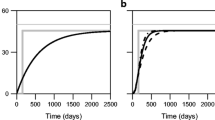Abstract
Effects of toxicants are commonly assessed at individual level, whereas the aim of ecotoxicology is to protect ecosystems. We recently built energy-based models to describe and predict growth, emergence and reproduction of the midge Chironomus riparius [Péry (2002) Environ. Toxicol. Chem. 21, 2507–13]. Here we use these models to derive effects at the population level from effects at individual levels. The first endpoint we consider is population growth rate, which is a commonly studied endpoint at the population level. This parameter is informative relative to the risk of disappearance of the population. We also examined the production of organisms per generation or per time unity at population equilibrium, the study of which is allowed by our models and accounts for energy transfers. Such a study is crucial to predict effects on ecosystems, for species of the Chironomidae are keystone species, being the main food source of many other species, including birds and fish. We show in our study that the disappearance of the population can only occur in cases of very severe toxicity (99% decrease of reproduction, more than 97% mortality during a 10 days survival test or a difference of mean emergence times between males and females of more than 10 days). Concerning production of organisms, we show that reproduction decrease has little effect on it, that mortality of young larvae has an impact that cannot be neglected and that mortality of old larvae and delay of emergence has a strong effect. Our study suggests that bioassays should focus on an EC50 for reproduction, a LC30 for young instars, and a No Effect Concentration for old instars (growth and mortality) to prevent effects at the population level.
Similar content being viewed by others
References
P.D. Armitage P.S. Cranston L.C.V. Pinder (1995) The Chironomidae. Biology and Ecology of Non Biting Midges Chapman & Hall London, UK 572
M.B. Berg R.A. Hellenthal (1992) ArticleTitleThe role of chironomidae in energy flow of a lotic system Neth. J. Aquat. Ecol. 26 471–6
P. Calow R.M. Sibly V. Forbes (1997) ArticleTitleRisk assessment on the basis of simplified life-history scenarios Environ. Toxicol. Chem. 16 1983–9 Occurrence Handle1:CAS:528:DyaK2sXlslegurY%3D
N.J. Chura (1961) ArticleTitleFood availability and preferences of Juvenile Mallards Trans 26th N. Am. Wild. Conf. 2 121–34
T.D. Dawson J.J. Jenson T.J. Norberg-King (2000) ArticleTitleLaboratory culture of Chironomus tentans for use in toxicity testing: optimum initial egg-stocking densities Hydrobiologia 438 251–6
A.E.R. Downe (1973) ArticleTitleSome factors influencing insemination in laboratory swarms of Chironomus riparius (Diptera: Chironomidae) Can. Entomol. 105 291–8 Occurrence Handle10.4039/Ent105291-2
V.E. Forbes P. Calow (1999) ArticleTitleIs the per capita rate of increase a good measure of population-level effects in ecotoxicology Environ. Toxicol. Chem. 18 1544–56 Occurrence Handle1:CAS:528:DyaK1MXktVCjsr0%3D
B.R. Goddeeris A.C. Vermeulen E. DeGeest H. Jacobs B. Baert F. Ollevier (2001) ArticleTitleDiapause induction in the third and fourth instar of Chironomus riparius (Diptera) from Belgian lowland brooks Archiv fur Hydobiologie 150 307–27
A.J. Hendricks E.L. Enserink (1996) ArticleTitleModeling response of single-species populations to microcontaminants as a function of species size with examples for waterfleas (Daphnia magna) and cormorants (Phalocrocorax carbo) Ecol. Model. 88 247–62
A.E. Hershey (1985) ArticleTitleEffects of predatory sculpin on the chironomid communities of an artic lake Ecology 66 1131–8
H. Ineichen U. Riesen-Willi J. Fisher (1979) ArticleTitleExperimental contributions to the ecology of Chironomus (Diptera) : II. The influence of the photoperiod on the development of Chironomus plumosus in the 4th larval instar Oecologia 39 161–83
C. Klok A.M. De Roos (1996) ArticleTitlePopulation level consequences of toxicological influences on individual growth and reproduction in Lumbriculus rubellus (Lumbricidae, Oligochaeta) Ecotoxicol. Environ. Saf. 33 118–27 Occurrence Handle1:CAS:528:DyaK28XivVKht7o%3D Occurrence Handle8723748
S.A.L.M. Kooijman J.J.M. Bedaux (1996) The Analysis of Aquatic Toxicity Data. Vu University Press Amsterdam, The Netherlands 149
M.A. Learner R.W. Edwards (1966) ArticleTitleThe distribution of the midge Chironomus riparius in a polluted river system and its environs Air Water Pollut. 10 757–68 Occurrence Handle1:STN:280:DyaF2s%2FhsVajsQ%3D%3D Occurrence Handle5917584
W.R. Munns Jr. E.B. Dianne T.R. Gleason K. Salomon D. Bengston R. Gutjahr-Gobell (1997) ArticleTitleEvaluation of the effects of dioxin and PCBs on Fundulus heteroclitus populations using a modeling approach Environ. Toxicol. Chem. 16 1074–81
A.R.R. Péry V. Ducrot R. Mons J. Garric (2003) ArticleTitleModelling toxicity and mode of action of chemicals to analyse growth and emergence tests with the midge Chironomus riparius Aquatic. Toxicol. 65 281–92
A.R.R. Péry R. Mons P. Flammarion L. Lagadic J. Garric (2002) ArticleTitleA modelling approach to link food availability, growth, emergence and reproduction for the midge Chironomus riparius Environ. Toxicol. Chem. 21 2507–13 Occurrence Handle12389933
J.F. Postma M.C. Buckert-de Jong N. Staats C. Davids (1994) ArticleTitleChronic toxicity of cadmium to Chironomus riparius (Diptera: Chironomidae) at different food levels Arch. Environ. Contam. Toxicol. 26 1–17
R.M. Sibly (1999) ArticleTitlePopulation growth rate and carrying capacity should be the ecological endpoints Aspects Appl. Biol. 53 261–2
Author information
Authors and Affiliations
Corresponding author
Rights and permissions
About this article
Cite this article
Péry, A.R.R., Mons, R. & Garric, J. Energy-based Modeling to Study Population Growth Rate and Production for the Midge Chironomus riparius in Ecotoxicological Risk Assessment. Ecotoxicology 13, 647–656 (2004). https://doi.org/10.1007/s10646-003-4425-0
Accepted:
Issue Date:
DOI: https://doi.org/10.1007/s10646-003-4425-0




